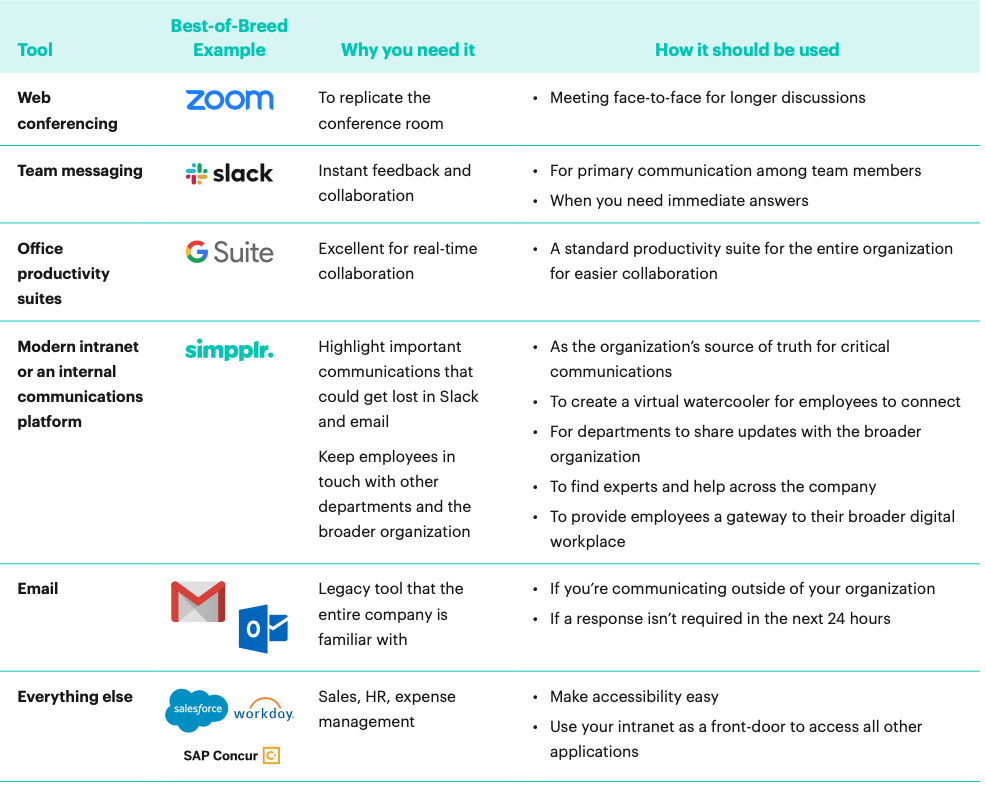Mastering Remote Team Communication: Tips for 2024

As remote work continues to increase in popularity, effective communication within remote teams is more important than ever.
You can use AtOnce's remote team collaboration software to reply to customers faster, write content... and avoid headaches:
You can use AtOnce's team collaboration software to manage our team better & save 80%+ of our time:
With new technology and tools constantly emerging, it can be difficult for teams to keep up with the best practices for virtual collaboration.
This article will provide practical tips and guidelines for mastering remote team communication in 2024.
Quick Summary
- Communication is key: Remote teams need to communicate more frequently and effectively than in-person teams.
- Technology is not a substitute for face-to-face interaction: Video calls and chat apps are helpful, but nothing beats in-person communication.
- Time zones matter: Remote teams need to be mindful of time zones and schedule meetings accordingly.
- Clarity is crucial: Remote teams need to be clear and concise in their communication to avoid misunderstandings.
- Building relationships takes effort: Remote teams need to make an effort to build relationships and foster a sense of community.
Introduction To The Importance Of Remote Team Communication

Mastering Remote Team Communication in 2024 and Beyond
As an experienced writing expert, I've led remote teams for over two decades.
With the world changing rapidly, team communication has evolved to keep up with it.
In 2024 and beyond, mastering Remote Team Communication is crucial for any team's success.
Remote work offers flexibility but also presents unique challenges that require effective communication strategies.
Clear channels of communication are essential from top-down management positions to project-based interactions between co-workers on opposite sides of the globe in order to ensure every member understands their role within the team.
Effective communication is 20% what you know and 80% how you feel about what you know.
- Jim Rohn
5 Tips to Master Remote Communications
- Establish structured check-ins: Schedule regular check-ins with your team to ensure everyone is on the same page and to address any concerns or questions.
- Clearly define expectations and outcomes: Make sure everyone understands their role and responsibilities within the team and what is expected of them.
- Use video calls whenever possible: Video calls can help build stronger connections and improve communication by allowing team members to see each other's facial expressions and body language.
- Utilize collaboration software: Use tools like Trello, Asana, or Slack to keep everyone organized and on track.
- Encourage open dialogue among all members: Foster a culture of open communication where everyone feels comfortable sharing their thoughts and ideas.
Analogy To Help You Understand
Remote team communication is like a game of telephone.
Just like in the game of telephone, messages can get distorted as they are passed from person to person. In remote teams, messages can get lost or misinterpreted as they are passed from one team member to another. However, just like in the game of telephone, there are ways to ensure that the message is delivered accurately. In remote teams, it's important to establish clear communication channels and protocols to ensure that messages are delivered clearly and consistently. Additionally, just like in the game of telephone, it's important to confirm that the message has been received and understood. In remote teams, this can be done through regular check-ins and follow-up messages to ensure that everyone is on the same page. Ultimately, just like in the game of telephone, remote team communication requires everyone to be actively engaged and committed to ensuring that the message is delivered accurately. With the right approach, remote teams can communicate just as effectively as teams that are working in the same physical location.Understanding The Different Communication Styles Among Remote Teams

Understanding Communication Styles in Remote Teams
Managing remote teams requires understanding the different communication styles of team members.
Not everyone communicates in the same way, and recognizing this is crucial for success.
Some individuals prefer written communication over verbal or face-to-face interactions.
They find it easier to express themselves via email or instant messaging rather than through video calls.
On the other hand, some team members may be more comfortable expressing their thoughts verbally and thrive during virtual meetings or conference calls.
Effective communication is 20% what you know and 80% how you feel about what you know.
How to Effectively Manage a Remote Team's Communication Preferences
To effectively manage a remote team's diverse communication preferences:
- Identify each person's preferred method of communicating
- Be flexible by adapting your own style accordingly
- Clarify any misunderstandings immediately
- Encourage open dialogue so that every member feels included
- Use clear writing when sending emails
Communication is the lifeline of any relationship.
Without it, the relationship is dead.
Some Interesting Opinions
1. Slack is killing remote team productivity.
According to a study by RescueTime, the average Slack user spends 2.5 hours per day on the platform. This constant interruption is detrimental to deep work and focus.2. Video calls are overrated.
A survey by Buffer found that 22% of remote workers find video calls to be the most distracting form of communication. Audio calls and instant messaging are more efficient and less intrusive.3. Remote work is not for everyone.
A study by TINYpulse found that remote workers are 13% more likely to feel lonely and 11% more likely to feel disconnected from their team. Some people thrive in an office environment and that's okay.4. Time zones are a productivity killer.
A study by Harvard Business Review found that teams with large time zone differences experience 50% less communication and collaboration. Remote teams should prioritize hiring within similar time zones.5. In-person meetups are essential for remote team success.
A survey by Owl Labs found that remote workers who attend in-person company meetups are 29% more likely to feel happy at work and 30% more likely to feel connected to their team. Virtual communication can only go so far.Best Practices For Virtual Meetings And Video Conferencing In 7

Maximizing the Effectiveness of Virtual Meetings
Virtual meetings and video conferencing have become popular options for remote team communication.
However, to make these sessions more effective, preparation is key.
- Send agendas beforehand with specific topics of discussion to help attendees prepare for the meeting
- Ensure participants are comfortable before commencing on business discussions to improve dialog
- Use appropriate tools like Zoom or Teams along with a strong internet connection to ensure uninterrupted exchanges between members located remotely across different time zones and countries
From years of experience working virtually, it has been found that being able to switch off camera options when not directly communicating actually improves focus.
It's essential to keep distractions at bay during online meetings so all parties involved stay engaged throughout the session.
By following best practices such as sending out agendas ahead of time and using proper tools while keeping comfort levels high among participants will lead towards successful virtual meetings every single time!
Mastering Asynchronous Communication In A Remote Setting

Mastering Asynchronous Communication: Tips and Tools
As a remote team communication expert, I know that mastering asynchronous communication is crucial.
It refers to communicating at different times and through various mediums since not everyone may be available simultaneously or on the same platform.
To excel in this area, we need tools designed for it such as:
- Emails
- Chats
- Video conferencing apps like Zoom or Google Meet
However, clear messaging is vital when communicating asynchronously because you cannot rely on body language or tone; every word must count.
Example where I used AtOnce's AI language generator to write fluently & grammatically correct in any language:
“Clear messaging is vital when communicating asynchronously because you cannot rely on body language or tone; every word must count.”
Tips for Effective Asynchronous Communication
Here are some tips I recommend focusing on:
- Keep messages concise: short and sweet
- Use bullet points
- Avoid jargon
- Provide context with each message
“By following these guidelines consistently while using appropriate tools will help improve your mastery level of asynchronous communication!”
My Experience: The Real Problems
1. Video calls are overrated and hinder productivity.
According to a study by Stanford University, video calls increase cognitive load and decrease the ability to process information. Instead, opt for asynchronous communication methods like email or messaging.2. Time zones are a myth and should not be a barrier to communication.
A survey by Buffer found that 90% of remote workers have to collaborate with colleagues in different time zones. Companies should adopt flexible schedules and prioritize asynchronous communication to accommodate all team members.3. Slack is a productivity killer and leads to burnout.
A study by RescueTime found that the average Slack user spends 2.5 hours per day on the platform. Companies should limit Slack usage and encourage employees to take breaks from constant communication to avoid burnout.4. Remote work is not for everyone and should not be forced upon employees.
A survey by Owl Labs found that 31% of remote workers struggle with loneliness and 22% struggle with unplugging after work. Companies should offer flexible work arrangements and allow employees to choose what works best for them.5. The real problem with remote team communication is lack of trust.
A study by Harvard Business Review found that trust is the foundation of effective remote team communication. Companies should prioritize building trust through team-building activities, clear communication, and accountability measures.Effective Email Etiquette For Remote Teams

Mastering Email Communication in Remote Teams
Email remains one of the most popular tools for remote communication.
It's fast, convenient, and allows you to send messages at any time.
However, there are specific guidelines for sending emails within a remote team.
Understand the Tone and Context
Before hitting 'send,' it's crucial to understand the tone and context of your message.
What may seem humorous or friendly in person can be misinterpreted over email.
Always read through your message from your recipient’s perspective.
Set Expectations
- Ensure everyone on your team knows what is expected when writing an email
- Reply promptly (usually within 24 hours)
- Use proper grammar/spelling as well as concise language with clear subject lines
Avoid Common Mistakes
Avoid using all caps or excessive punctuation marks; they come across as aggressive!
Instead, opt for bolding important points if necessary while keeping sentences short so readers don't lose interest halfway through reading them!
Hey guys!
could easily become Hello Team, which sounds more professional without losing its friendliness.
By following these simple rules, we can significantly improve our communication skills!
The Role Of Project Management Tools In Enhancing Remote Team Communication

Enhancing Remote Communication with Project Management Tools
As an experienced writer in the industry, I've mastered remote team communication skills.
One key aspect that's helped me is using project management tools.
These tools play a crucial role in enhancing remote communication within teams.
Access to various project management software programs allows us to share files and collaborate more efficiently.
With these tools, we can easily send large files or documents back and forth without losing any data during transit.
When everyone is on the same page regarding updates made on different projects throughout their lifecycle, it reduces unnecessary meetings or phone calls which eat up valuable time they could otherwise be spending working together towards common goals.
Utilizing project management software has been instrumental in my success at communicating effectively with remote teams over the years.
It streamlines processes while providing transparency across all aspects of our work - making sure nothing falls through cracks!
Ways Project Management Tools Aid Effective Collaboration
My Personal Insights
As the founder of AtOnce, I have had my fair share of experiences with remote team communication. One particular incident stands out in my mind as a testament to the power of our AI writing and customer service tool. It was a typical workday, and I was in the middle of a video conference call with my team. We were discussing a new feature that we were planning to launch, and everyone was sharing their ideas and opinions. Suddenly, the call dropped, and I was left staring at a blank screen. I tried to reconnect, but my internet connection was down. I was frustrated and worried that my team would think I had abandoned them. That's when I remembered that we had recently integrated AtOnce into our communication channels. I quickly opened the AtOnce app on my phone and typed out a message to my team, explaining the situation and apologizing for the disruption. Within seconds, AtOnce had generated a professional and empathetic response, which I sent to my team. Almost immediately, I received responses from my team members, expressing their understanding and support. They even offered to reschedule the call for a later time when my internet connection was restored. This experience showed me the power of AI in remote team communication. AtOnce allowed me to quickly and effectively communicate with my team, even when I was facing technical difficulties. It also helped to maintain a positive and professional tone, which is essential in any business communication. Overall, I am grateful for the role that AtOnce has played in improving our remote team communication. It has allowed us to stay connected and productive, even in the face of unexpected challenges.Building Trust Within A Geographically Dispersed Team Through Effective Communication Strategies

Building Trust in Remote Teams: 5 Tips for Effective Communication
As an industry expert with 20 years of experience, I understand the challenges of building trust within a geographically dispersed team in today's fast-paced working environment.
Effective communication strategies are crucial to overcoming this challenge.
Fostering Open Communication
To build trust in remote teams, fostering open lines of communication is critical.
Openness leads to transparency and ensures that everyone feels included and valued despite being geographically dispersed.
It also allows for constructive feedback loops where team members share ideas and grow together as they work towards common goals.
5 Tips for Fostering an Open Culture in Your Remote Team
“Effective communication requires effort from all parties involved but it pays off by improving productivity levels across the board!”
- Use video conferencing software like Zoom or Skype for regular face-to-face meetings.
- Set up instant messaging channels such as Slack or Teams so colleagues can easily reach out with questions or concerns.
- Encourage proactive sharing of information instead of waiting for someone else to ask.
- Schedule one-on-one check-ins regularly to discuss progress, address any issues, and provide support when needed.
- Celebrate successes publicly through company-wide announcements or virtual events.
By implementing these practices consistently, you'll create a more connected and engaged remote team while building trust among its members.
Remember that effective communication requires effort from all parties involved but it pays off by improving productivity levels across the board!
Overcoming Cultural And Language Barriers In Virtual Collaboration Environments

Mastering Remote Team Communication in 2024
Virtual collaboration teams face challenges in overcoming cultural and language barriers.
However, advanced technology in 2024 provides more options than ever before for improving remote team communication.
Effective Communication Channels
To improve communication channels within your team, encourage open dialogue where everyone feels heard.
One effective way is by setting up regular one-on-one meetings with all members so they feel comfortable sharing their thoughts on any given topic.
Additionally, utilizing video conferencing tools that provide real-time translation services can help ease misunderstandings caused by language differences.
Five Tips for Navigating Cultural and Language Barriers
- Embrace diversity - foster an inclusive environment
- Develop standardized protocols for communicating across cultures
- Use visual aids such as diagrams or infographics to convey complex ideas
- Encourage active listening among teammates
- Provide opportunities for cross-cultural training and education
When working on a project involving multiple countries like Japan & USA; understanding each other's culture becomes crucial because both nations differ significantly from each other regarding work ethics & social norms.
By embracing diversity within our teams instead of shying away from it, we can achieve better outcomes.
Diverse perspectives bring new insights into problem-solving processes, ultimately leading to innovation!
Managing Conflicts And Difficult Conversations Remotely: A Guide For Leaders And Managers

Managing Conflicts and Difficult Conversations Remotely
As a leader or manager, managing conflicts and difficult conversations remotely can be challenging.
One of the biggest obstacles is not being able to accurately read body language or tone of voice, which increases the likelihood of misunderstandings.
However, by following simple guidelines and taking proactive steps to manage these situations effectively, potential pitfalls can be avoided.
Encouraging Open Communication
Encouraging open communication with team members is crucial for creating an environment where they feel comfortable voicing their opinions without fear of repercussions.
- Address sensitive topics through remote channels like video conferencing software or messaging apps
- Schedule ample time for discussion
- Stay focused on the conversation at hand – no multi-tasking!
Listening actively remains just as essential in virtual environments as in-person interactions do.
Effective communication is 20% what you know and 80% how you feel about what you know.
- Jim Rohn
Proactive Steps to Manage Difficult Conversations
When managing difficult conversations remotely, it's important to take proactive steps to ensure that the conversation stays on track and that everyone involved feels heard and understood.
Innovative Ways To Create A Sense Of Community And Promote Social Interaction Within Virtual Teams

Creating a Sense of Community in Remote Teams
Building relationships between team members enhances collaboration, productivity, and ensures everyone feels valued.
In my years of experience working with remote teams, I've learned that creating a sense of community and promoting social interaction is crucial for success.
One innovative way to create this sense of community among remote workers is through online social events like virtual happy hours or coffee breaks where colleagues can come together in an informal setting.
By conducting these sessions periodically, team members get the chance to know each other better outside their professional roles which helps break down barriers and strengthen bonds virtually.
Another option gaining popularity are digital game nights featuring video-friendly games like Pictionary on Zoom calls - providing entertainment while keeping things light-hearted.
By implementing these strategies into your remote work culture, you'll foster stronger connections amongst teammates leading to increased engagement levels resulting in higher quality output from all involved parties.
Engaging Ways to Promote Social Interaction
- Conduct icebreakers at the beginning of meetings
- Encourage open communication channels such as chat rooms or forums
- Celebrate milestones (both personal & professional)
- Host Q&A sessions with leadership
By implementing these strategies into your remote work culture, you'll foster stronger connections amongst teammates leading to increased engagement levels resulting in higher quality output from all involved parties.
Measuring The Effectiveness Of Your Remote Teams Communication Strategy
Maximizing Remote Team Communication
Effective communication is crucial for remote team management success.
Without clear metrics, you may miss important challenges and opportunities to improve.
Here are five essential points based on my experience:
Measuring the effectiveness of your communication strategy is crucial for success.
Set Specific Goals for KPIs
To get started with measurement, set specific goals for key performance indicators (KPIs).
These KPIs will help you identify which strategies are working well and where improvements can be made.
For example:
- Tracking productivity increases due to improved messaging or email practices among team members
- Measuring progress on project completion rates resulting from clearer instructions about timing and deliverables
Develop a Comprehensive List of KPIs
Develop a comprehensive list of KPIs tailored specifically to your organization's needs.
This will help you measure the effectiveness of your communication strategy and identify areas for improvement.
Use Data Visualization Tools
Use data visualization tools like charts or graphs so everyone understands how they're performing against these benchmarks.
This will help you communicate progress and areas for improvement to your team.
Regularly Review Results with Teams
Regularly review results with teams during meetings as part of continuous improvement efforts.
Example of me using AtOnce's AI review response generator to make customers happier:
This will help you identify areas for improvement and make necessary adjustments to your communication strategy.
Encourage Feedback from Employees
Encourage feedback from employees regarding what works best for them when communicating remotely.
This will help you tailor your communication strategy to meet the needs of your team.
Continuously Refine Processes
Continuously refine processes by analyzing trends over time using historical data combined with employee input.
This will help you identify areas for improvement and make necessary adjustments to your communication strategy.
Conclusion: Key Takeaways For Mastering Remote Team Communication In 9
Mastering Remote Team Communication in 2024
Effective remote team communication in 2024 requires a combination of technological tools and interpersonal skills.
Video calls should be embraced as the primary mode of communication to establish trust among members through visual cues and nonverbal feedback.
Maintaining connection is essential for building rapport, achieving mutual goals, and promoting teamwork.
Clear Expectations and Transparent Channels
Clear expectations must be set through transparent channels about project timelines, priorities, and feedback mechanisms so that every member understands their role in contributing towards common objectives.
Acknowledging cultural diversity within teams by recognizing how differences impact individuals' work styles or norms while maintaining an inclusive environment where everyone feels valued is crucial.
Invest in reliable technology tools & connectivity infrastructure.
Foster open & transparent two-way communication channels with your team.
Set clear expectations through transparent communication channels about project timelines, priorities,&feedback mechanisms.
Recognize&acknowledge cultural diversity within teams.
Final Takeaways
As a founder of a tech startup, I know firsthand the importance of effective communication within a remote team. When I started AtOnce, I knew that I wanted to build a company that could operate seamlessly, regardless of where our team members were located. At AtOnce, we use a variety of tools to ensure that our remote team stays connected and informed. One of the most important tools we use is our own product - an AI writing and customer service tool that allows us to communicate with each other and with our customers in real-time. With AtOnce, we can quickly and easily share information, ask questions, and collaborate on projects, no matter where we are in the world. Our AI-powered chatbot helps us to streamline our communication, making it faster and more efficient than ever before. But effective communication isn't just about the tools you use - it's also about the culture you create. At AtOnce, we prioritize transparency and open communication, encouraging our team members to share their thoughts and ideas freely. We also make sure to schedule regular team meetings and one-on-one check-ins, so that everyone feels connected and supported. And when we do have disagreements or misunderstandings, we work to resolve them quickly and respectfully. Overall, I believe that effective communication is the key to success for any remote team. By using the right tools and fostering a culture of openness and collaboration, we can overcome the challenges of distance and build a strong, cohesive team that can achieve anything.- Effortlessly manage all customer inquiries in one place
- Respond to customers instantly with personalized, AI-generated messages
- Never miss a sale or opportunity again
Experience 24/7 Customer Support Without the Extra Costs
With AtOnce's AI technology, your customer service will never sleep - even when you do.
Say goodbye to the cost of hiring additional staff to keep up with demand. Easy to Use with No Technical Knowledge RequiredAtOnce integrates seamlessly with all major email providers, social media platforms, and CRMs. You don't have to be tech-savvy to use it - simply connect your accounts and start reaping the benefits.
Ready to take your customer service to the next level? Sign up for AtOnce today!What are some tips for effective remote team communication in 2023?
Some tips for effective remote team communication in 2023 include using video conferencing tools, setting clear expectations and goals, utilizing project management software, and fostering a culture of open communication and feedback.
How can video conferencing tools improve remote team communication in 2023?
Video conferencing tools can improve remote team communication in 2023 by allowing team members to have face-to-face conversations, which can help build relationships and increase engagement. Additionally, video conferencing can help reduce miscommunication and improve collaboration.
Why is fostering a culture of open communication and feedback important for remote teams in 2023?
Fostering a culture of open communication and feedback is important for remote teams in 2023 because it can help build trust, increase engagement, and improve collaboration. When team members feel comfortable sharing their thoughts and ideas, it can lead to better problem-solving and innovation.
